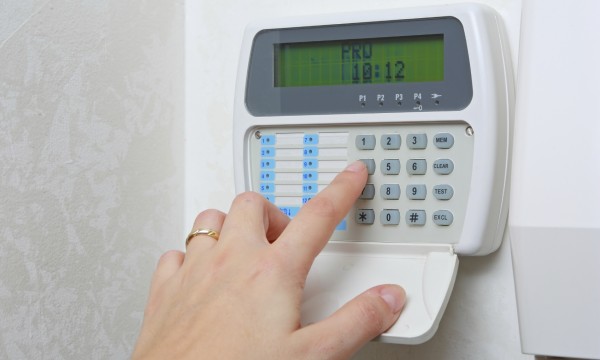A house alarm system adds another layer of security to your home. It works by securing doors and windows, as well as placing motion sensors throughout your home.
When a break-in is detected, the sensors will send a signal to your control panel, which then triggers a high-decibel alarm and possibly other devices, such as strobe lights. This alerts you to the issue, as well as the authorities if the system is professionally monitored.
Sensors
There are several types of sensors that can be used in a house alarm system. The most basic are motion detectors. They detect movement by creating a radio frequency field between two sensor pieces that can be triggered by anything that disturbs the field. The type of disturbance that triggers the alarm can vary, but some include infrared, ultrasonic, and vibration. Dual technology sensors use more than one form of detection in order to reduce the number of false alarms. These sensors can be wired into the alarm system or they can function wirelessly. If the sensors are wireless they may require battery power, which needs to be checked regularly.
Another type of sensor is a contact switch. This sensor has two parts that connect with each other by magnets. When the magnetic connection is broken, it flips a switch and signals to the alarm panel that something is amiss. These sensors are commonly installed on doors and windows. They can also be added to gates, such as backyard or pool gates, and even drawers where valuable items are kept.
Alternatively, there are passive infrared (PIR) detectors. These sensors detect the infrared energy emitted from body heat and respond accordingly. They can be triggered by an intruder’s presence or simply by changes in ambient temperature. PIR detectors can be prone to false alarms, such as from pets or dust, but they are a good choice for people who want more advanced detection.
There are also door and window sensors that use a different type of detection. These sensors emit a magnetic field that can be detected by an intruder or even by some electronic devices. This kind of sensor is usually attached to the interior door frame and will send an alert to the control panel if it is breached, whether or not the alarm is armed.
Besides the sensors, the alarm system will need a keypad for arming and disarming. These can be either wired or wireless and may feature indicator lights or a small multi-character display. The keypad can also be used to change the settings on the sensors and other features of the alarm system. Most home security companies provide these as part of the initial installation.
Circuits
Alarms are triggered when one of the sensors detects activity. The sensor circuits transmit electrical signals to the control box, which either closes a loop circuit or sends a signal to a remote monitor that the sensors have activated. These systems are often used in homes and small businesses and provide a simple, low-cost security solution. The control box may also dial the police directly if it receives a call from a sensor, playing a pre-recorded message that gives the address of the home. In many cases the system will also dial the security company that installed the equipment, allowing it to feed the police with more specific information about the intrusion, such as which sensors were tripped and the exact time they were activated.
Most residential alarm systems use a cellular or radio network to communicate with a central monitoring station, but they can also be connected to PSTN lines. These are generally used in situations where a remote building does not have a direct phone line and where the cost of trenching and running a new wire is too high. Some systems also have a redundant communication path built into them, using a second encoded cellular or radio device to bypass the phone line completely and thus thwart intentional tampering.
A basic burglar alarm uses a sensor that senses current flowing through a metal foil that is affixed to the door or window glass. If the foil is broken, it breaks the circuit and triggers an alarm. You can purchase silver foil tape with a self-adhesive backing that is designed to do just this, and it is usually available wherever you buy your house alarm systems.
When you have a number of hardwired zones, it is recommended to put an EOL (earth of leakage) resistor in the circuit. This resistor reduces the voltage on the circuit when the system is tripped, and can help to prevent damage to your valuable electronics. You will need to check your alarm panel or devices for the correct size of EOL resistor to use in the circuit.
Control Box
A control panel is the hub of any alarm system. It connects with a user’s security devices, life-safety devices and home automation devices to manage them all. The control panel is where the users can see what each device is doing and enables them to change their settings. It’s also where they can arm or disarm their security system. There are two main types of alarm systems: hardwired and wireless. Both use a control box to link up their door sensors, motions, keypads and sirens together. If you have a hardwired system it’s usually hidden in a closet or in the garage and if you have a wireless smart alarm system it may be built into your alarm’s keypad.
Modern alarm panels have a vast array of features that allow users to customize their set-up in many ways. These include setting the time that the alarm will activate and when it will deactivate, as well as creating a custom schedule for your system to follow. You can also choose what type of alerts you want the system to send you, including a text or email. These will let you know if someone has tampered with your sensor or if the alarm was triggered by a fire, smoke or carbon monoxide event.
For businesses dealing with dangerous chemicals, an alarm panel can also display real-time data for each sensor. This feature allows the system to be connected to a facility’s network and accessed by engineers remotely, which can help avoid costly mistakes like undetected gas leaks.
In addition, the alarm panel can also signal to the building that a drill is taking place. Depending on the system’s configuration, this may silence the audible alarms while strobe lights continue to operate. This can make the evacuation process much smoother and is a great way to get the building ready for reoccupation after a fire or other emergency.
Whether you have a wired or a wireless security system, your control panel is vital to keeping the house safe and secure. Ideally, it should be hidden away in a secure location, so it can’t be easily tampered with or destroyed. If you’re moving into a property with an alarm, it’s worth asking the previous owners or estate agent where the alarm control panel is located so you can find it quickly (if necessary).
Monitoring
Many alarm systems offer professional monitoring by trained personnel. If the system is armed and activated, it signals an alert to the central station, and depending on how the system is configured, this can trigger a number of actions. It might call the police, fire department or other emergency response team, play a prerecorded message on an answering machine to give contact information and tell them that there is an intrusion, or it may simply notify you via phone, text or email. This feature reduces the chance of false alarms by notifying you when a sensor has been tripped and can help you track down what caused it if you are not at home.
Some systems use dual signaling, using a telephone line and a cellular radio network to send alarm signals at high speed. This can be a good choice for homes without existing landline phones, or for those who don’t want to install an alarm panel on their property. Dual-signaling systems can also reduce costs by reducing the number of wires needed to connect sensors to the control box.
Alternatively, some systems use a standard IP (Internet Protocol) to communicate with the central station. This has become the most popular approach for DIY and pro-install systems alike, especially those that allow for a smartphone app to monitor and control a home security system. IP-based systems typically offer a lower price point than traditional alarms, and are often backward compatible with older alarms that do not use the same communication protocol.
The sensors, motion detectors and door and window contacts in a house alarm system work together to detect an intrusion and report it to the control panel. The control box then sounds an audible alarm, and sends a message to the homeowner or monitoring company over a telephone line or a cellular connection (depending on the system). The most common cellular protocols used in home alarm systems are Z-Wave and iControl’s OpenHome, but there are a variety of options available.
A professionally-monitored system will also connect to a local monitoring service, such as the one offered by SafeHomeCentral. Rather than connecting to the control box, this connection is made over a separate digital cellular communications unit, which usually uses a battery backup. This means that the alarm system will still work during a power outage, and the cellular connection will not be affected by telephone circuits that might otherwise be occupied by other calls or texts. Increasingly, the central station will employ a system of enhanced call verification to make sure that an alarm is genuine before dispatching law enforcement officers to the premises. This system requires them to try a set sequence of callbacks to the property owner and others before calling emergency services.


















